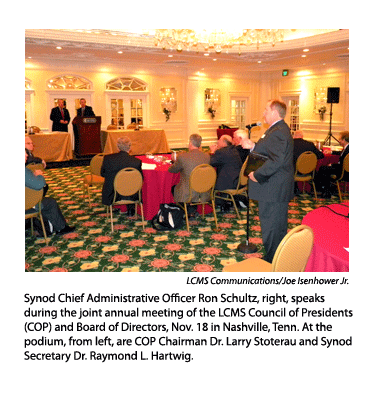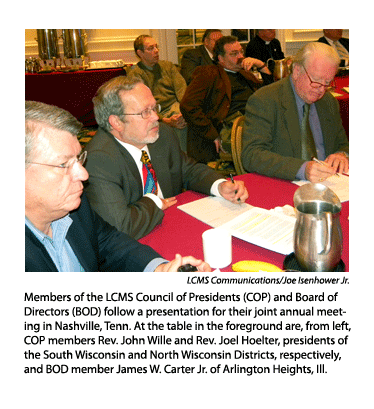By Joe Isenhower Jr.
NASHVILLE, Tenn. — Members of the Task Force on Synodical Harmony and representatives of the Synod president’s office will meet to discuss the task force’s final report, including possible ways to mesh recommended strategies 
That decision came at a joint Nov. 18 annual meeting of the LCMS Council of Presidents (COP) and Board of Directors (BOD). Both groups held individual meetings here prior to the Lutheran Church Extension Fund’s Nov. 19-21 Fall Leadership Conference.
Task force members in the discussions will be the three who represent the COP and the three representing the BOD.
The harmony task force grew out of a resolution adopted by the 2007 Synod convention, which called for a plan to restore harmony throughout the Synod. The COP and BOD then established the 12-member task force to recommend a strategy for harmony.
After numerous meetings and hearings that involved a cross-section of rostered and lay members in the Synod, the task force issued a progress report that appeared in the 2010 Convention Workbook.
A resolution adopted by that convention’s delegates includes encouraging the task force to continue its work of developing specific strategies. In its final report to the COP and BOD, the task force presents nine strategies.
The report notes that the task force invited Synod First Vice-President Rev. Herbert C. Mueller Jr. to a meeting in September, when he presented a concept paper on the Koinonia Project and the task force
The Koinonia Project is part of Synod President Rev. Matthew C. Harrison’s three-point emphasis of “Witness, Mercy, Life Together.”
“We are encouraged,” the task force states in its final report, “that ‘Life Together’ (‘koinonia’ [in Greek]) is to be a major focus of the Synod as we face the future. We believe that the work this task force has done over the last triennium can be a key piece toward improving our life together in The Lutheran Church-Missouri Synod.”
Also in the final report, the task force points out that early in its work, “we defined harmony as, ‘The oneness that believers in Christ seek to manifest and express in their life together as God’s people.’ “
“I believe it is our intention with the Koinonia Project to seek to fold these strategies into [the project],” Mueller said in the Nov. 18 joint meeting. “What the harmony task force has done cannot be lost. It must be carried forward.”
Rev. Paul Sieveking, LCMS Iowa District West president and chairman of the task force, told those at the joint meeting that “it has been a humbling experience – the trust that you’ve placed in the work of the task force. We appreciate the opportunity to serve that you’ve given us. We have had the opportunity to listen to the LCMS in what we believe is a representative group of many viewpoints from across the Synod. And it has been an honor to see that, while there is disharmony, we saw some wonderful Christian brothers and sisters coming together around the concern for harmony in our church body.”
Sieveking told Reporter that the final task force report will be posted to the LCMS website after the six members of the task force and representatives of the Synod president’s office meet. No date had been set for that meeting when this article was prepared.
The COP and BOD also decided during their session together that six members (three from each group) will meet with LCMS Secretary Dr. Raymond L. Hartwig to look into both groups’ assignments from the 2010 convention — to set boundaries for five regions of the Synod.
The Board and Council are to complete that assignment at least 24 months prior to each Synod convention, “appropriately considering geographical and number of congregations information,” according to a 2010 convention resolution.
Among changes to the Synod’s structure and governance adopted by the convention are provisions for electing by geographic region five vice-presidents, five members of the Board of Directors, and the members of the new Boards for National and International Mission.
Also during the joint meeting, Hartwig listed seven areas of cooperation between the Synod Council of Presidents and Board of Directors, and the Board and Council chairmen gave an overview of their groups’ individual meetings.
“It is very helpful for the Council of Presidents to meet with the Board of Directors and share common concerns and challenges,” COP Chairman Dr. Larry Stoterau, president of the LCMS Pacific Southwest District, told Reporter by e-mail. “I find this annual meeting to be an excellent opportunity for good communication between the COP and BOD.”
Dr. Robert T. Kuhn, chairman of the Board and a president emeritus of the Synod, wrote via e-mail that he considered this year’s joint session to be “an excellent meeting. There were many new faces in both groups.”
Posted Dec. 8, 2010

